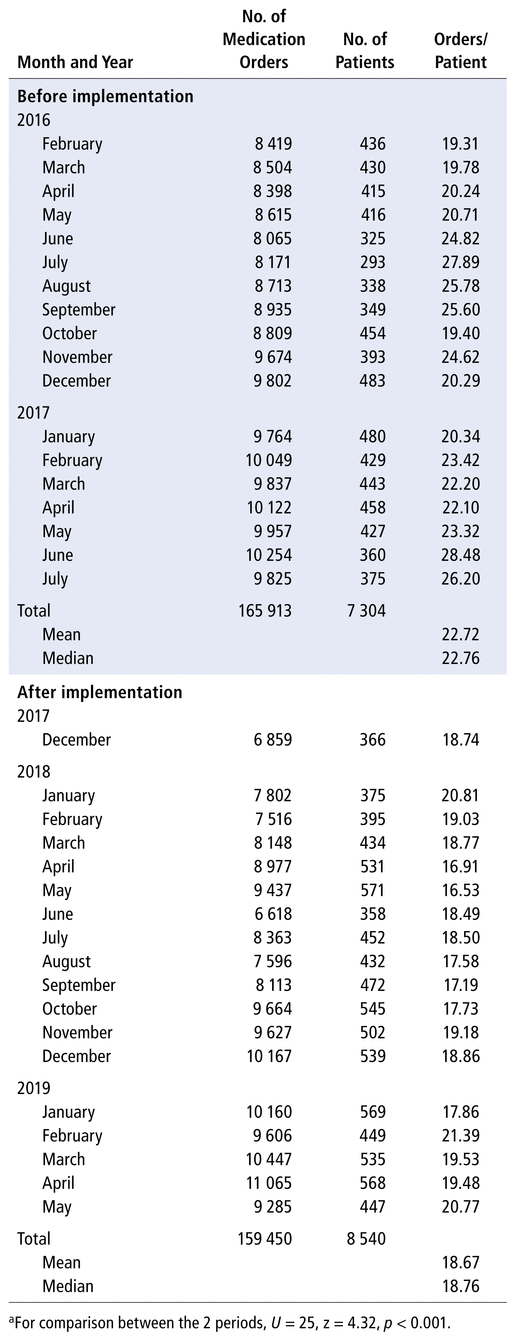
Meshaal Mohammed Eisa Hamad, Sulaiman BahABSTRACT
Background
Medication errors can cause severe injuries and may lead to death. Electronic health records (EHRs) that are well designed and implemented could help to reduce medication errors. The medication management process needs close study to understand how medication safety metrics evolve as hospitals mature in terms of their EHR implementation.
Objective
To examine the effect of adopting EHRs on medication errors at the Royal Commission Hospital in Jubail, Saudi Arabia, a Health Information Management System Society (HIMSS) stage 6 hospital.
Methods
This study had a quasi-experimental time-series design. Retrospective data were collected for 1.5-year periods before and after implementation of EHRs. The variables analyzed were obtained from various units in the study setting. Data on medication errors were collected from the risk management section of the quality department. The medication management process was studied qualitatively. The quantitative data were analyzed using descriptive and inferential statistics.
Results
The median number of medication orders per patient showed a significant decrease, from 22.76 before EHR implementation to 18.76 after implementation (p < 0.001). The median number of incidents per patient showed a significant increase, from 0.029 before to 0.040 after implementation (p = 0.004). The qualitative analysis of processes involved in the medication management process helped to explain these changes.
Conclusion
Contrary to expectations, this study showed that an HIMSS stage 6 hospital could experience an increase in medication errors following implementation of EHRs. Qualitative analysis showed that the increase in medication error reporting rate could be attributed to an increase in detection following improvement in the medication management process. This has implications for interpreting quality metrics as hospitals mature in terms of their EHR implementation.
KEYWORDS: electronic health record, medication errors, medication safety, pharmacist intervention
RÉSUMÉ
Contexte
Les erreurs de médication peuvent causer des blessures graves et entraîner la mort. La bonne conception et la mise en place de dossiers de santé électroniques (DSE) pourraient aider à les réduire. Le processus de gestion des médicaments doit faire l’objet d’un examen attentif pour comprendre comment les paramètres de sécurité relatifs aux médicaments évoluent à mesure que les hôpitaux se modernisent grâce à la mise en place de DSE.
Objectifs
Examiner l’effet de l’adoption des DSE sur les erreurs de médication au Royal Commission Hospital de Jubail, en Arabie saoudite, un hôpital de stade 6 de la Health Information Management System Society (HIMSS).
Méthodes
Cette étude utilisait une méthodologie de série chronologique quasi expérimentale. Des données rétrospectives ont été recueillies pendant des périodes de 1,5 an avant et 1,5 an après la mise en place des DSE. Les variables analysées ont été obtenues à partir de diverses unités dans le cadre de l’étude. Les données sur les erreurs de médication ont été recueillies auprès de la section de gestion des risques du service qualité. Le processus de gestion des médicaments, quant à lui, a été étudié de manière qualitative. Les données quantitatives ont été analysées à l’aide de statistiques descriptives et inférentielles.
Résultats
Le nombre médian d’ordonnances médicales par patient a fortement diminué, passant de 22,76 avant à 18,76 après la mise en place des DSE (p < 0,001). Le nombre médian d’incidents par patient a quant à lui augmenté de manière importante et est passé de 0,029 avant à 0,040 après la mise en place des DES (p = 0,004). Les résultats de l’analyse qualitative des étapes du processus de gestion des médicaments expliquent en partie ces changements.
Conclusion
Contrairement aux attentes, cette étude a montré qu’un hôpital de stade 6 de la HIMSS pourrait connaître une augmentation des erreurs de médication à la suite de la mise en place de DSE. L’analyse qualitative a montré que l’augmentation du taux de déclaration des erreurs de médication pouvait être attribuée à une augmentation de la détection suivant l’amélioration du processus de gestion des médicaments. Ce constat a des implications pour l’interprétation des indicateurs de la qualité à mesure que les hôpitaux se modernisent en mettant en place des DSE.
MOTS CLÉS: dossier de santé électronique, erreurs de médication, sécurité des médicaments, intervention en pharmacie
Medication safety plays an important role in reducing medication errors. All health care providers (including hospital pharmacists) are collectively responsible for reducing medication errors. In the modern era, health care providers are digitally connected through electronic health records (EHRs). The EHR serves as the information-gathering medium for the patient. As reported by Atasoy and others,1
Ideally, information gathering begins before a patient encounter, retrieving records from other providers or past patient encounters. This, and other information, is then updated at the beginning of the patient’s interaction with the physician or nursing staff; additional data—such as lab values, images, and progress notes—are added as the encounter progresses.
At a minimum, the EHR facilitates documentation and communication among health care providers, reduces misunderstanding and miscommunication, and expedites the provision of care. EHR systems can be enhanced to include e-prescribing, as well as testing for drug–drug interactions, testing for drug allergies, testing for dosing errors, and subsequent documentation of the results of testing once completed.2 In general, the benefits of EHRs far outweigh their drawbacks.2–5
Despite the many advantages of EHRs, medication errors continue to occur. From the perspective of the hospital pharmacist, medication errors “may occur in the storage, prescribing, transcription, preparation and dispensing, or administration and monitoring of medications.”6 Hence, for the purpose of enhancing the role of hospital pharmacists in reducing medication errors, the International Pharmaceutical Federation, in its revised “Basel Statements on the Future of Hospital Pharmacy” (approved in 2014), made several pertinent recommendations. Some of these recommendations deal with the interaction of the pharmacist with the EHR for the purposes of documentation and therapeutic decision-making.7 In this regard, Nelson and others8 performed a literature review and summarized 3 main ways in which pharmacists use EHRs. The first is documentation, which includes medication reconciliation notes, allergy documentation, and “interventions”. The second is medication reconciliation, which includes comparing and contrasting medication lists and “[evaluating] effectiveness and adverse drug events.” The third is patient evaluation and monitoring, which includes “identifying potential medication problems, reviewing medication regiments, [and] checking drug-drug interactions”.8
It is thus important to shed light on the pharmacist’s role in medication safety within the EHR environment. However, given that EHR implementation is not uniform in all health care settings, a yardstick is needed to measure the level of implementation in each setting, to better contextualize the pharmacist’s role. A good tool for this purpose is the Health Information Management Systems Society (HIMSS) electronic medical record adoption model (EMRAM).9 This model, developed in 2005, comprises 8 stages, numbered from 0 to 7. At stage 0, none of the 3 ancillaries (laboratory, radiology, and pharmacy) is installed. At stage 1, EHR systems are installed in all 3 ancillaries. Over time, the EHR system matures progressively until, by stage 7, it has become paperless.9 In this staging process, metrics are developed for monitoring progress from one stage to the next. This model assumes a steady increase in “indicators of good performance” and, correspondingly, a steady decrease in “indicators of poor performance”. For example, medication errors are reduced by stage 4 and eliminated by stage 6.9
Evidence is now emerging to challenge this narrative. As Bowman10 has pointed out, it is not merely the design of the EHR system that is important, but also its implementation, or how it is incorporated into clinical processes and how users apply it in routine clinical care. In short, there is a qualitative dimension to the use of EHRs, which is manifested in many ways. One example is found in the early literature on factors leading to the slow adoption of EHRs by physicians, despite availability.1 The quantification of medication errors can be complemented by a qualitative investigation of process factors involved in the implementation of EHRs.
The study reported here takes a closer look at medication management within an EHR system. Once the EHR system has been implemented, it is expected that the medication management process—including assessing, prescribing, verifying and dispensing orders, administering, and monitoring—will change, either through the addition of new options or the modification of previous options. These new options, such as electronic medication reconciliation and availability of drug guidelines, would directly integrate standard pharmacy functions with the EHR. For such integration, pharmacists should be applying these options and providing the system team with feedback by reporting any medication errors that do occur.
The aims of the study were to compare the incidence of medication errors and the medication error reporting process before and after implementation of EHRs. The specific objectives were to calculate quantitative indicators of medication safety, to describe qualitative indicators of medication safety, to compare qualitative and quantitative indicators of medication safety before and after implementation of EHRs, and to ascertain the effect of EHR implementation on medication safety. It was anticipated that the results would be useful in reviewing the health care quality metrics as EHR systems progress from one HIMSS EMRAM stage to the next.
The study was conducted at the Royal Commission Hospital in Jubail, Saudi Arabia, a 200-bed secondary care hospital providing inpatient and outpatient care to the local population. The hospital uses a commercial EHR system (BestCare), which was implemented on October 31, 2017. At the time of the study, the hospital was ranked at HIMSS stage 6; more recently, in November 2021, it was elevated to HIMSS stage 7.
The study received ethics approval from Imam Abdulrahman Bin Faisal University (IRB-PGS-2020-03-003) and the study setting where the research was conducted.
The study had a quasi-experimental time-series design and was based on retrospective data for a 1.5-year period before the implementation of EHRs (February 1, 2016, to July 30, 2017) and a 1.5-year period after implementation (December 1, 2018, to May 31, 2019). Included in the study were incident reports and pharmacist interventions related to medication errors. A pharmacist intervention refers to action taken from the pharmacist to the prescriber intended to prevent a medication error. Before EHR implementation, medical staff submitted incident reports manually to the risk management unit; after EHR implementation, incidents were reported electronically to the same unit. Incident reports and pharmacist interventions not related to medication errors during the study period were excluded (e.g., adverse drug reactions and patients’ refusal of medication therapy).
The study was a full population study (not a sample), because all medication errors satisfying the inclusion criteria were considered. The data (for all inpatients) for different units in the study setting were based on monthly reports obtained from the risk management department (incident reports) or the pharmacy department (pharmacist interventions). The medication errors were classified by staff members in the study setting (i.e., the Royal Commission Hospital) as wrong dose, wrong drug, drug–drug interaction, missed dose, wrong patient, wrong route, wrong dilution, wrong time, wrong frequency, wrong unit, wrong formula, expired medication, and contraindicated drug.
For the analysis, 2 sets of data were collected, quantitative (based on the monthly reports) and qualitative. The monthly reports on medication-related incidents and medication orders (before and after EHR implementation) were normalized by patient data for comparability. The z-test for difference in proportion was used to compare proportions, and the Mann-Whitney U test was used to compare medians. Statistical significance was defined as p < 0.05. The analyses were done using PAST software.11 The qualitative variables refer to medication management process functions before and after EHR implementation. Using a qualitative approach, the medication management process was broken down into steps, and the risks of medication error before and after EHR implementation were identified and analyzed.
Depending on the number of patients seen, monthly medication orders at a hospital can run into the hundreds or thousands. Table 1 shows the monthly numbers of medication orders in relation to the number of patients at the study site before and after EHR implementation. The median medication order per patient was 22.76 before EHR implementation and 18.76 after implementation. According to the Mann-Whitney U test, the difference between the medians was statistically significant (p < 0.001). Similarly, Table 2 shows the monthly incident reports in relation to the number of patients at the study site before and after EHR implementation. The median incidents per patient was 0.029 before EHR implementation and 0.040 after implementation. According to the Mann-Whitney U test, the difference between the medians was statistically significant (p = 0.004).
TABLE 1 Medication Orders per Patient before and after Implementation of Electronic Health Recordsa

TABLE 2 Incidents per Patient before and after Implementation of Electronic Health Recordsa
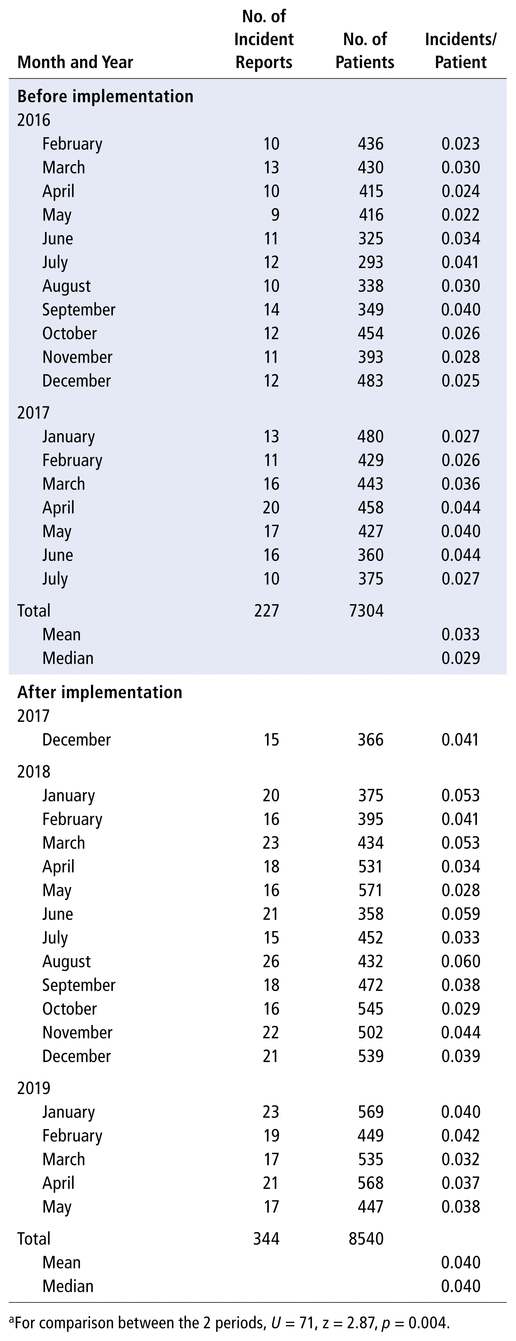
The breakdown of medication errors by type is shown in Table 3 for the period before implementation and in Table 4 for the period after implementation. The most frequent type of error before EHR implementation was wrong-dose errors (42 reports), followed by wrong-drug errors (33 reports), whereas errors involving expired medication were least frequent (3 reports) (Table 3). After EHR implementation, the pattern for most and least frequent error types was similar: wrong-dose errors remained most frequent (121 reports), followed by wrong-drug errors (95 reports), with errors involving expired medication being least frequent (3 reports) (Table 4).
TABLE 3 Types of Errors before Implementation of Electronic Health Records, February 2016 to July 2017
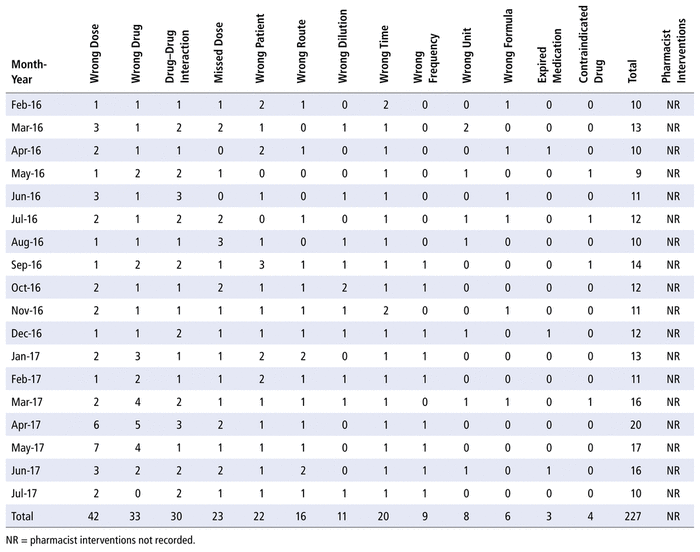
TABLE 4 Types of Errors after Implementation of Electronic Health Records, December 2017 to May 2019
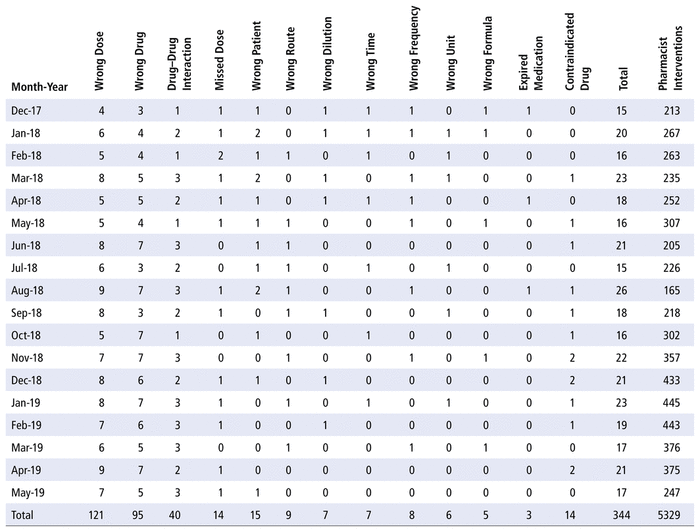
Before implementation of the EHR system, pharmacist interventions were performed but not recorded (Table 3). After implementation, pharmacist interventions were documented automatically in the EHR system (Table 4). The total number of pharmacist interventions in the post-implementation period was 5329, with the highest monthly total (n = 445) in January 2019. In addition, the highest monthly number of reported errors after implementation (n = 26 in August 2018) did not correspond to the highest monthly number of orders, but rather to the lowest number of pharmacist interventions (165).
To complement this quantitative analysis, a qualitative description of pharmacist interventions and the medication management process was carried out and is summarized in Table 5. The overall process was subdivided as follows: assessing, prescribing, verifying and dispensing the order, administering the drug, and monitoring. The pharmacist’s role changed considerably during EHR implementation. For example, in terms of preparation of a discharge medication summary, such summaries were not available before EHR implementation but could be generated by the system after implementation. Similarly, 9 of the 10 steps in the prescribing process were not done before EHR implementation, but these were all feasible after implementation. For the verifying and dispensing process, 5 of the 9 steps were not available before EHR implementation, but could be added afterward. For the administering process, 2 of the 3 steps were not done before EHR implementation, but could be done afterward. Finally, for the monitoring process, 6 of the 8 steps were not done before EHR, but could be done afterward. Some of the steps (e.g., in the prescribing, verifying and dispensing, and monitoring processes) became easier and clearer after EHR implementation. Finally, some steps that were formerly completed manually could be completed electronically after EHR implementation (in the prescribing, verifying and dispensing, and monitoring processes).
TABLE 5 Steps of Medication Management Process before and after Implementation of Electronic Health Records
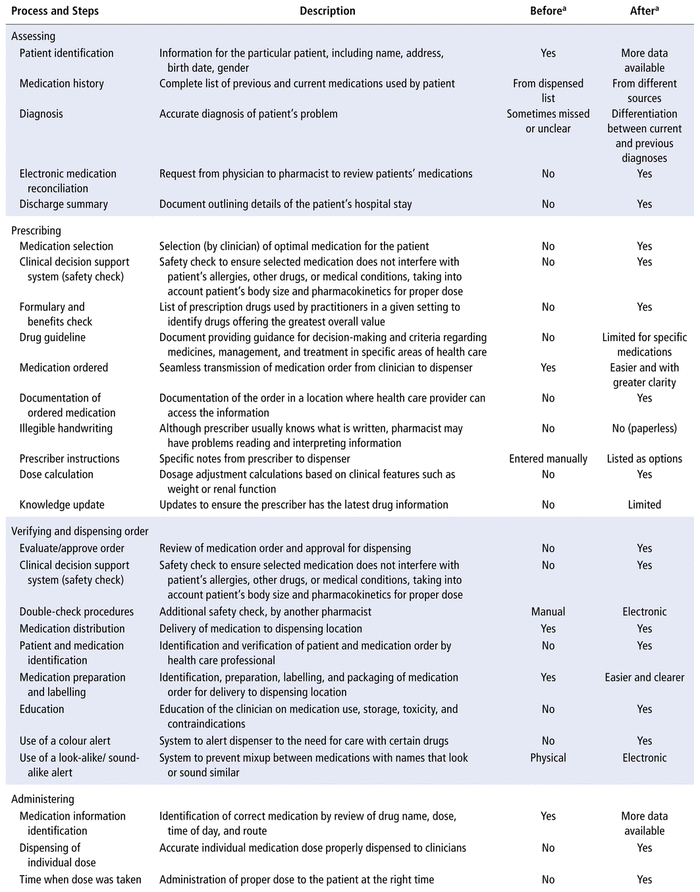
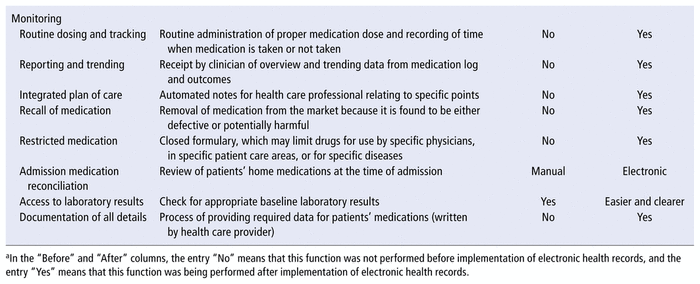
Table 5 shows that various pharmacist interventions are important aspects of the medication management process that help to increase error detection. For example, during the verifying process, if the pharmacist has any concerns during review of medication orders, they will advise the prescriber by means of an intervention. This process is added to the medication management process, which helps the pharmacist to write notes immediately. In addition, such interventions are automatically documented in the patient’s file.
With the introduction of EHR systems in hospitals, it is expected that medication errors will decline. In addition, with EHR systems that include a pharmacy module and clinical decision support features, further reductions in medication errors are expected.4 These were our expectations for the current study. In addition, for the particular study setting, we expected that the total number of medication orders would increase over time, following the addition of new medical services, such as hyperbaric medicine, plastic surgery, and extended care. However, the findings were opposite to both expectations. More specifically, the number of medication orders declined and the number of medication errors increased after implementation of the EHR system. This counterintuitive finding could only be explained by a qualitative study of the system from the pharmacist’s perspective.
In our qualitative study, we found several reasons for the reduction in medication orders. First, the new options available in the EHR system solved some previously existing problems. For example, the new system does not continue processing an order if the requested medication is not included in the hospital’s drug formulary. Second, for medications with different dose strengths, prescribers sometimes had to enter more than 1 order for the same medication to obtain the desired amount; however, the EHR system allows automatic selection of the most suitable dosage with a single medication order, which has thus reduced the overall number of medication orders. Third, in the new system, use of the “order setting” decreases the number of medication orders because prescriptions for several medications can be combined in a single order, especially for orders with more than 2 components; previously, a separate order would have been required for each component.
We identified several reasons for the unexpected increase in the number of incident reports related to medication errors after EHR implementation. First, pharmacists on the EHR team played a role in guiding the design of the system, by determining their needs and desired changes from the existing system and how they could integrate the new system into their workflow. This higher level of awareness contributed to a higher error detection rate than before EHR implementation. This finding aligns with a study that observed cognitive workload changes among nurses during the transition from a manual system to an EHR system.12 Second, the new system allowed pharmacists to see more details of individual prescriptions, including information about the prescriber (consultant or specialist), specific instructions, and the patient’s medication history. Third, the pharmacy supervisor could monitor workflow through the new system, which helped in managing the medication-use process, identifying particular users (prescribers or dispensers), tracking the time of ordering and dispensing, and even determining the particular medication given to an individual patient; pharmacists are expected to be more alert to medication errors with this level of supervision. Fourth, the new system facilitated communication among health care providers in case of order changes or the addition of instructions from the prescriber. This option allowed pharmacists to see deleted or cancelled orders and the person who made the change; it also allowed pharmacists to write notes for the prescriber, whenever errors involving double entries, wrong patient, or wrong dose were detected. Fifth, after EHR implementation, pharmacists had easy access to many services that helped them check laboratory results to verify whether a medication dispensed from the pharmacy had been given to a patient or not. Sixth, the quality department modified the incident report window, making it easier to access. This facilitated the documentation of incidents and automatic reporting to the risk unit, which again helped in increasing the reporting of medication errors.
One of the main limitations of this study was the manual documentation of pharmacist interventions before EHR implementation; as such, data were not available for comparison with interventions after EHR implementation (which were recorded in the system). Another limitation was the small number of errors analyzed, given that pharmacists reported only 344 errors out of 5329 interventions (less than 7%). Finally, another limitation of this study is that the risk unit in the quality department modified the incident report window at the study setting, with the result that staff members understood well how to use it. This may have helped staff members to report medication errors better than before.
The EHR system introduced at the study site significantly changed the medication management process. Changes were manifested at all stages of the medication management process, including assessing, prescribing, verifying and dispensing of orders, administering medications, and monitoring. Collectively, these changes led to decrease in the number of medication orders per patient and an increase in the error detection rate. Notably, this study showed that an HIMSS stage 6 hospital could experience an increase in errors with implementation of an EHR system. This might also happen if a hospital facility were to “leapfrog” from a manual system to a high stage in the HIMSS EMRAM.
The results of this study suggest that the information technology unit in the study setting could consider including pharmacist interventions for the purposes of incident reporting and could create an option for such interventions within the EHR system. This might improve clarity and avoid duplication of work. Finally, health care providers are urged to report any medication errors to the risk management unit to improve medication safety and other clinical care services.
1 Atasoy H, Greenwood BN, McCullough JS. The digitization of patient care: a review of the effects of electronic health records on health care quality and utilization. Annu Rev Public Health. 2019;40:487–500.
Crossref
2 Menachemi N, Collum TH. Benefits and drawbacks of electronic health record systems. Risk Manag Healthc Policy. 2011;4:47–55.
Crossref
3 Manca D. Do electronic medical records improve quality of care? Yes. Can Family Physician. 2015;61(10):846–7.
4 Griever M. Do electronic medical records improve quality of care? No. Can Family Physician. 2015;61(10):847–9.
5 Radley DC, Wasserman MR, Olsho LE, Shoemaker SJ, Spranca MD, Bradshaw B. Reduction in medication errors in hospitals due to adoption of computerized provider order entry systems. J Am Med Inform Assoc. 2013;20(3):470–6.
Crossref PubMed PMC
6 Mansur JM. Medication safety systems and the important role of pharmacists. Drugs Aging. 2016;33(3):213–21.
Crossref PubMed
7 Revised FIP Basel statements on the future of hospital pharmacy. International Pharmaceutical Federation, Hospital Pharmacy Section; 2014 [cited 2021 Dec 20]. Available from: https://www.fip.org/files/fip/FIP_BASEL_STATEMENTS_ON_THE_FUTURE_OF_HOSPITAL_PHARMACY_2015.pdf
8 Nelson SD, Poikonen J, Reese T, El Halta D, Weir C. The pharmacist and the EHR. J Am Med Inform Assoc. 2017;24(1):193–7.
Crossref
9 Rayner J, Chinwadzimba P. Five things you need to know about HIMSS EMRAM attainment. Oracle; 2019 Nov 29 [cited 2021 Dec 20]. Available from: https://www.cerner.com/gb/en/blog/five-things-you-need-to-know-about-himss-emram-attainment
10 Bowman S. Impact of electronic health record systems on information integrity: quality and safety implications. Perspect Health Inf Manag. 2013;10(Fall):1c.
PubMed PMC
11 Hammer Ø, Harper DAT, Ryan PD. PAST: paleontological statistics software package for education and data analysis. Palaeontol Electr. 2001 [cited 2021 Dec 20];4:9 p. Available from: http://palaeo-electronica.org/2001_1/past/issue1_01.htm
12 Colligan L, Potts HWW, Finn CT, Sinkin RA. Cognitive workload changes for nurses transitioning from a legacy system with paper documentation to a commercial electronic health record. Int J Med Inform. 2015;84(7):469–76.
Crossref PubMed
Competing interests: None declared. ( Return to Text )
Funding: None received. ( Return to Text )
Canadian Journal of Hospital Pharmacy, VOLUME 75, NUMBER 4, Fall 2022